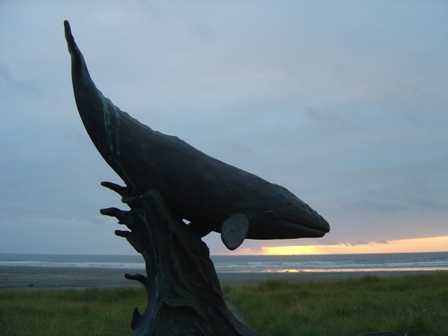Approaching the Long Beach peninsula, I was convinced that the grey skies which had blanketed over me for several hours would spoil the final minutes of daylight as well. Nevertheless, I checked into my hotel, then walked toward the beach, hoping for the best.

That small break in the cloud gave me some hope for the sunset, so in the meantime, I explored the long boardwalk that runs along the sand dunes near the water.

Along the boardwalk, you’ll find a small statue and plaque noting the importance of whales in this corner of the country. Tourists can watch for the creatures as they migrate off the coast.
William Clark (of Lewis and Clark fame) was fascinated by one of the giant creatures which had washed ashore, just a few miles south of here (at Cannon Beach). The expedition benefitted from 300 pounds of its blubber, which had been cured by the local Native Americans.

Nearly two centuries later, a gray whale beached and died on Long Beach. To control the odor as the whale decomposed, it was buried on the beach. In 2002, students and biologists located the skeleton, and excavated it. Now, it’s on display near the boardwalk.

The sunset is looking a little more promising now.

The sun broke through for just a matter of minutes, giving me the great sunset I was hoping for.
Morning on Day 4 brought more grey skies, and some annoying rain showers. But I did a little exploring in town, despite the weather.

As the name suggests, Long Beach is, indeed, an impressively long (28 miles!) expanse of sand. You’ll find the landmark arch near a record-holding piece of cast iron cookery.

Be sure to check out the World’s Largest Frying Pan, right at the center of town on Rte. 103.
Note: This trip was first published in 2004.







No comments